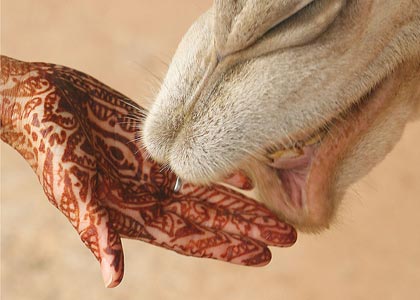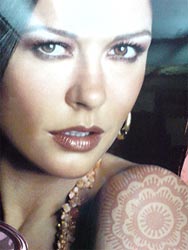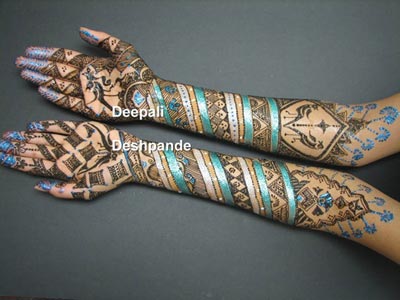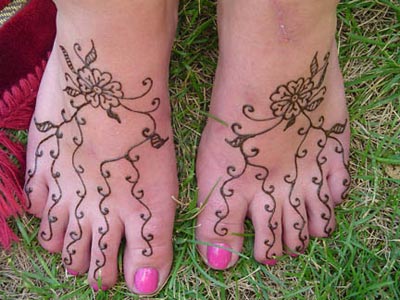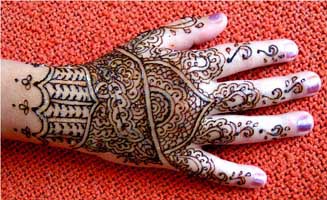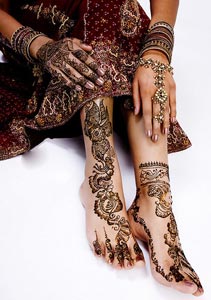What Is Henna?
Webster: a reddish-brown dye obtained from leaves of the henna plant
Henna is a plant which grows in hot, dry regions like the Middle East and Northern Africa. The leaves are dried and pulverized into a powder. The powder is the main ingredient used to create the paste needed for henna tattoos. Henna paste stains skin just as a wet teabag stains a white tablecloth. Artists apply henna paste in patterns on people’s skin, and that will leave a temporary stain when the paste falls off. The henna stain will be orange when the paste comes off, and that stain will darken to a dark brick red or brown color in 48 hours.
Henna Quick Facts:
|
Henna – A history
Henna is considered to be one of the oldest cosmetics in the world, and has been used on skin, nails and hair for centuries. Its uses have been documented as far back as 9,000 years ago, having been utilized by several cultures including: India, Egypt, Africa, Sumeria, the Middle East, and along the Mediterranean. It originated as a form of celebrating victory and fertility by ancient peoples; it was also used in the mummification process by the ancient Egyptians. Henna was used by notable and illustrious historical figures including: Queen of Sheba, Nefertiti, Fatima, and Cleopatra.
Catherine Cartwright-Jones: Regarded by many people as the world’s leading authority on the history, traditions, chemistry and techniques of henna. She is pursuing a PhD in the history and traditions of henna, and lectures on the subject at schools, conferences, and colleges in the US and abroad. She has authored many publications on henna. She is also a henna artist, and has 14 years of professional henna experience, in addition to more than 30 years experience as a professional illustrator.
Henna – Associations & Organizing bodies
International Certification for Henna Artists (ICNHA) – “A volunteer peer assessment for Henna Artists. The objective of this examination is to test and certify a henna artist’s understanding of the fundamental principles of henna, skin, hygiene, safety, culture and traditions. If an artist knows these principles, the artist can more effectively serve a diverse clientele safely, effectively, and sensitively.” (ICNHA website)
Henna Arts International (HAI) – “Henna Arts International is a service organization of henna and mehndi artists, both professionals and enthusiasts. It is dedicated to positive promotion of this ancient art form in the modern world, disseminating reliable information on the subject, and addressing the needs and concerns of both its members and the henna/mehndi consumer.” (HAI website)
Henna Tribe – Serves as an “online community, informational resource, and professional network for anyone interested in the ancient art of applying henna to skin…[and] seek to create an egalitarian community where diverse henna artists and enthusiasts treat each other with professionalism and the respect we believe all human beings deserve.” (Henna Tribe website)
The dangers of black “henna”
“Black henna” is not henna at all, but rather a chemical hair dye, most likely containing Para-phenylenediamine (PPD) that is sometimes added to natural henna paste to give it the look of “real” tattoos. PPD is a commercial dye that when applied to the skin can cause allergic reaction, itching, oozing, and possibly scarring in the areas on which it has been used. In very rare and tragic cases, it can cause permanent organ damage and is considered a carcinogen.
Here are some things to keep in mind to make safe henna choices:
- Natural henna results in an immediate orange stain that darkens over the course of a couple days.
- Black henna” results in an immediate dark stain on the skin.
- Natural henna needs to sit before it is effective. The longer it sits (3 hours is best!) the darker the orange stain will become.
- Black henna” will only need to sit for an hour to have a dark brown or black stain.
Henna – Current popularity
Celebrities such as Madonna, Demi Moore, Catherine Zeta-Jones, Liv Tyler, Gwen Stefani, Elijah Wood, Prince, Sting, and others have brought henna’s popularity to the US and UK. It is a staple on boardwalks, beaches, resorts, and pretty much anywhere anyone wants just one more excuse to show a little skin (or partially enhance the skin that’s already showing).
|
|
Bridal henna, as it is practiced in Middle Eastern countries, is comparable to a having a manicure or pedicure done before a Western wedding. Traditionally, a bride is not allowed to perform any work around the house or otherwise until the henna applied to her hands and feet have completely faded. This form of henna is has been passed down through the generations and remains today as important to both those honoring past tradition – and those who just want to add that special something to their wedding day beyond the normal French manicure.
|
|
Party henna has become increasingly popular over the last several years. As its name suggests, the practice is now being incorporated as a central activitiy for different types of parties and functions. Many people find its unique allure the perfect way to help celebrate many of life’s special events including: weddings, bachelorette parties, baby showers, birthdays, and bat mitzvahs. Henna is also a common feature at drummings, ceremonies and rituals.
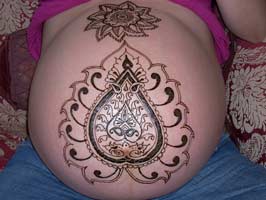 Above image: Angela Skrade Above image: Angela Skrade |
Belly henna is the practice of hennaing pregnant women. Hennaing in the late trimester is supposed to encourage a safe and healthy delivery, and is believed to protect both the mother and child from evil spirits. Because the pH level a woman’s skin will change while she is pregnant, the paste may not dye the skin as dark as it would otherwise. However, the intensity of the stain will vary from woman to woman and is usually darkest during early trimesters.
Conventions & Retreats
|
|
Henna conventions, conferences and retreats are a great way for practitioners and enthusiasts alike to spend some time with those who share a common bond through henna. One such convention is the Las Vegas Henna & Body art Conference held in Sin City. Others are the UK Henna Conference and the Pacific Northwest Henna Conference. These conventions offer lectures, courses, and seminars for practitioners to hone and refine their craft.
Conclusion
|
|
Henna is an exquisite, intricate art form in which the human body is an open canvas. Its ancient roots and deep cultural history have stood the test of time. Incorporating henna into modern-day activities honors those who created the beautiful tradition so long ago. Henna is seductive, unique and mysterious. Anyone who experiences henna firsthand will indeed be captivated by its exotic and infinite beauty.




